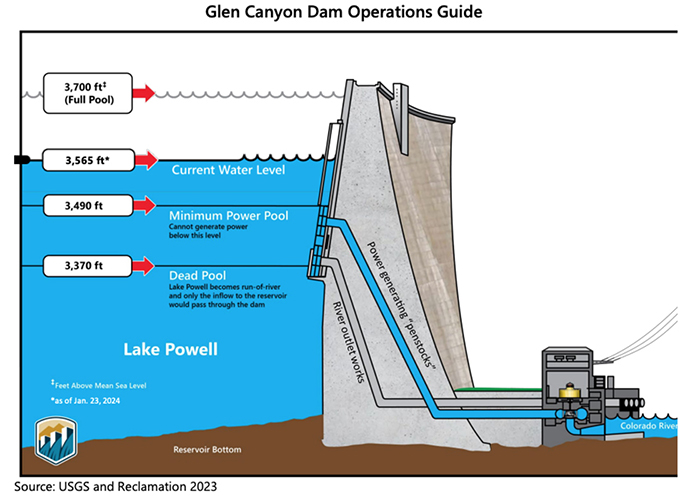
The threatened humpback chub is native to the Colorado River, but conservationists worry that falling levels at Lake Powell may let nonnative fish – predators – into the chub’s lower Colorado habitat. (Photo courtesy U.S. Fish and Wildlife Service)
Federal water managers proposed a new plan to protect native fish species in the Grand Canyon, but conservation groups say it does not go far enough.
The native species at issue is the humpback chub, which is found nowhere on earth besides the Colorado River and its tributaries. Decades after it was declared an endangered species, conservation efforts had allowed its populations to recover to the point that the fish could upgraded to “threatened” in 2021.
But the could be imperiled by falling water levels in Lake Powell, the nation’s second-largest reservoir, which have been dropping to historic lows as the region struggles with a decades-long drought. Those low water levels have allowed nonnative fish to pass through the Glen Canyon Dam, which holds back Lake Powell, and eat native fish – like the humpback chub – that live on the other side, in the portion of the Colorado River that runs through the Grand Canyon.
Lake Powell, which began filling in the 1960s, was stocked with nonnative fish such as smallmouth bass for recreational fishing in 1982. Smallmouth bass prefer warm water near the reservoir’s surface, but with the surface dropping, the fish are able to move low enough to enter the tubes inside Glen Canyon Dam that allow water to pass from one side to the other.

A diagram of Glen Canyon Dam shows tubes through which fish in Lake Powell might be able to reach the downriver section of the Colorado River. (Graphic courtesy U.S. Geological Survey/Bureau of Reclamation)
The Bureau of Reclamation, the federal agency that manages the West’s dams and reservoirs, released a draft plan this month for water releases from the dam in northern Arizona. It proposed five new ways to manage releases from the dam in an effort to keep native fish thriving in the Colorado River below Lake Powell – four of which involve attempts to make the water cooler and disrupt the spawning patterns of non-native fish.
Taylor McKinnon, Southwest director for the Center for Biological Diversity, takes issue with two components of the draft plan. The first, he said, is a tangible change” McKinnon encouraged federal water managers to consider making physical changes to the dam intakes themselves ¬- like adding screens – to keep fish from passing through.
“The Bureau of Reclamation has lots of very smart engineers on staff,” he said. “The fact that they have not figured out how to do this to date shows that they have not made it a priority.”
The second issue McKinnon described is more of an ideological one. He said federal water managers are not doing enough to look at the long-term viability of the reservoir in the face of a drying climate.
“Federal agencies need to become proactive,” he said. “They need to look at the science. They need to look at the forecasts for future Colorado River flows in one decade, two decades. All that information indicates that Glen Canyon Dam is facing climate-inevitable deadpool and climate-inevitable obsolescence.”
Deadpool is the point at which water in Lake Powell drops too low to pass water through Glen Canyon Dam. A number of conservation groups are encouraging water managers to consider a future where the dam and reservoir are taken out of use.
The Bureau of Reclamation’s draft plan is now in a 45-day public comment period, which began on Feb, 9.
-This story is part of ongoing coverage of the Colorado River, produced by KUNC and supported by the Walton Family Foundation.